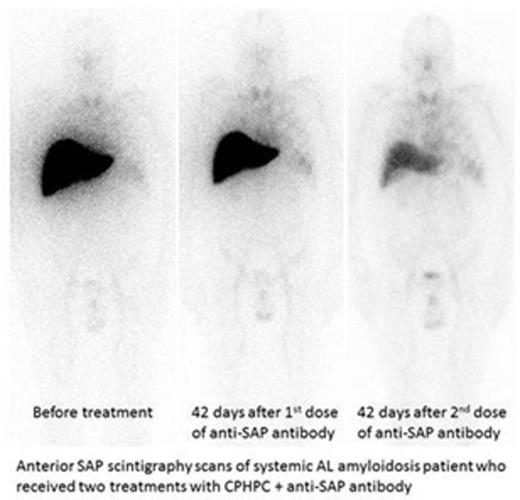Abstract
In systemic amyloidosis, disease is caused by the extracellular accumulation of amyloid fibrils which do not elicit the normally efficient mechanisms of clearance of interstitial debris, and which progressively disrupt tissue architecture and function. Diagnosis is often late, with advanced organ dysfunction and major morbidity. The condition is usually fatal despite organ support and efforts to reduce production of the fibril precursor protein. In the most common type, AL, caused by monoclonal gammopathy, treatment with cytotoxic chemotherapy can slow or arrest amyloid deposition in some patients, and amyloid deposits may sometimes slowly regress but about 20% of patients still die within 6 months of diagnosis. No specific interventions exist for many of the rarer forms of systemic amyloidosis. Directly targeted measures are required to specifically remove amyloid deposits in order to preserve and possibly restore organ function. We have identified the normal plasma protein, serum amyloid P component (SAP), as a therapeutic target for this purpose.
SAP binds to amyloid fibrils of all types and is thus always present in human amyloid deposits. Acute administration of (R)-1-[6-[(R)-2-carboxy-pyrrolidin-1-yl]-6-oxo-hexanoyl]pyrrolidine-2-carboxylic acid (CPHPC), swiftly depletes circulating SAP but leaves some SAP in amyloid deposits as an amyloid-specific antigen target. In patients with systemic AL, AA and AApoAI amyloidosis, we have lately reported that, following depletion of circulating SAP by CPHPC, a single dose of humanized monoclonal anti-SAP antibody substantially reduced the amyloid load, especially from the liver (D.B. Richards et al, New England Journal of Medicine, July 15, 2015; DOI: 10.1056/NEJMoa1504942). Here we show that repeated administration of the obligate therapeutic partnership of CPHPC with appropriate doses of anti-SAP antibody, progressively removed amyloid from the liver and other organs, including the kidney.
Up to three antibody doses were given at intervals to patients, mostly with AL or AFib amyloidosis, in this second part of a phase I dose-ascending study. Treatments were generally well tolerated. Infusion reactions were largely mitigated by hydrocortisone and antihistamine premedication. Pharmacodynamic responses were associated with an early transient inflammatory cytokine response and increased CRP and SAA production, followed by substantial depletion of plasma C3 and a less marked fall in C4 and CH50. Pharmacodynamic responses were sometimes associated with self-limiting cutaneous rashes, especially in subjects without hepatic amyloidosis. Reduced amyloid load was demonstrated by radiolabelled SAP scintigraphy (liver, spleen, kidneys), extracellular volume measurement by equilibrium MRI (liver, spleen) and liver stiffness determined by transient elastography. Amyloid removal was not associated with detectable additional organ dysfunction. Abnormal liver function tests improved following clearance of hepatic amyloid. Renal parameters were stable but follow up is still too short to ascertain long term renal effects.
In the preclinical mouse model, amyloid clearance mediated by anti-SAP antibody requires complement and macrophages and is effected by multinucleated giant cells. Consistent with this mechanism, the extent of amyloid clearance in patients depended on the dose of anti-SAP antibody in relation to the whole body amyloid load. In patients with hepatic and splenic amyloid, the anti-SAP antibody rapidly disappeared from the circulation, consistent with its easy access to these organs via their sinusoidal endothelium. Liver and spleen amyloid were cleared first but, after major reduction of liver and spleen load, renal amyloid was cleared by subsequent antibody doses.
These preliminary observations demonstrate that progressive amyloid removal can probably be achieved in all types of systemic amyloidosis by repeated courses of CPHPC and anti-SAP antibody. A phase II study is now planned.
This program is funded by GlaxoSmithKline.
Pepys:Pentraxin Therapeutics Ltd: Equity Ownership, Membership on an entity's Board of Directors or advisory committees, Patents & Royalties; UK NIHR: Research Funding; UK MRC: Research Funding. Cookson:GlaxoSmithKline: Employment, Equity Ownership. Barton:GlaxoSmithKline: Employment, Equity Ownership. Berges:GlaxoSmithKline: Employment, Equity Ownership. Moon:GlaxoSmithKline: Consultancy, Research Funding. Richards:GlaxoSmithKline: Employment, Equity Ownership.
Author notes
Asterisk with author names denotes non-ASH members.


This feature is available to Subscribers Only
Sign In or Create an Account Close Modal